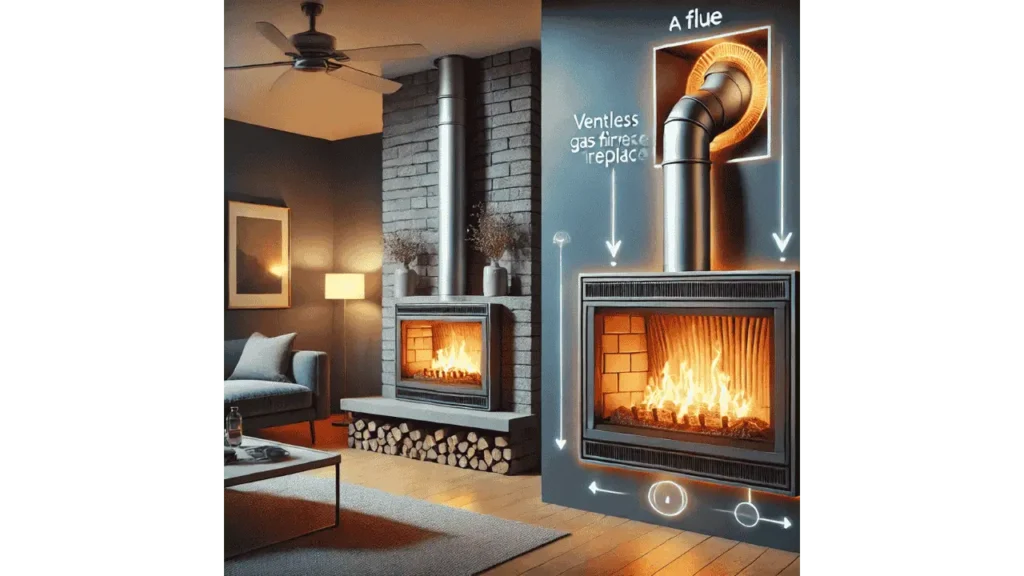Wondering if your gas fireplace needs a flue or feeling unsure about the best venting option? It can be confusing, especially when you’re trying to keep your home both warm and safe. The good news is, whether you go with a vented or ventless fireplace, there’s a solution for every setup. In this article, we’ll break down what a flue is, the different venting systems available, and the pros and cons of each, helping you make the right choice for your space.
Do You Need a Flue for a Gas Fireplace?
Whether or not you need a flue for your gas fireplace depends on the type of fireplace you have. Some gas fireplaces are vented, requiring a flue to direct combustion gasses outside, while others are ventless, designed to operate safely without one.
If you have a vented gas fireplace, the flue plays a crucial role in removing harmful byproducts like carbon monoxide. On the other hand, ventless fireplaces burn gas so efficiently that they don’t need a flue. I remember when I first installed my gas fireplace, deciding on the venting system was a key part of the process, getting it right made a huge difference in both safety and comfort!
What is a flue?
A flue is essentially a passageway, usually inside a chimney, that allows smoke and gasses from your fireplace to escape outside. In gas fireplaces, it works to vent harmful combustion byproducts, keeping the air in your home safe to breathe. Think of it as the fireplace’s exhaust system, it directs everything unwanted outside, so you can enjoy the warmth without worrying about gas buildup.
What are the different types of flues?
There are two main types of flues used in gas fireplaces: natural vent and direct vent. A natural vent (or B-vent) relies on the natural flow of air, pulling indoor air for combustion and venting the gasses through a chimney. On the other hand, a direct vent system uses a sealed pipe to pull in outdoor air for combustion and expel gasses outside, making it more efficient and safer for indoor air quality. Both types serve the same purpose, venting gasses, but how they work and the air they use can affect your home’s efficiency and safety.
Do you really need a flue for your gas fireplace?
Whether you need a flue depends on your fireplace type. Vented gas fireplaces, like direct vent and natural vent models, do require a flue to safely expel gasses. However, ventless gas fireplaces don’t need a flue at all, they’re designed to burn gas cleanly, so there’s no need for venting. If you’re considering a new fireplace, it’s important to choose based on your home’s setup and what works best for your comfort and safety.
Two Types of Vented Gas Fireplace Technology
Gas fireplaces that require venting come in two main types: natural vent and direct vent. Both have their own unique features and benefits.
Natural Vent (B-Vent)
A natural vent system pulls indoor air for combustion and vents gasses out through a chimney or flue. While easier to install if you already have a chimney, it’s less efficient as it can draw warm air out of the room.
Direct Vent
Direct vent fireplaces use a sealed system to pull in outside air for combustion and vent gasses directly outside. This makes them more energy-efficient and better for indoor air quality, as no indoor air is used or lost in the process.
Pros and Cons of Vented Gas Fireplaces
Vented gas fireplaces offer great heat and the look of a traditional fireplace, but they have their ups and downs. The pros include improved air quality (especially with direct vent models) and better energy efficiency compared to wood-burning units. However, the cons are that they require a more complex installation, especially if you need a new flue or chimney.
Pros and Cons of Ventless Fireplaces
Ventless gas fireplaces are super convenient and easy to install since they don’t require a flue. Pros include greater flexibility in placement and lower installation costs. On the downside, some people find they add too much moisture to the air or notice slight odors. In some regions, ventless fireplaces may also be restricted due to safety regulations.
Bottom Line
Whether your gas fireplace needs a flue depends on the type you choose. Vented fireplaces offer safety and efficiency with proper venting, while ventless options provide more flexibility and easier installation. Both have their pros and cons, but by understanding your home’s needs, you can pick the perfect option to keep things warm, cozy, and safe.
- Can You Install an Electric Fireplace Anywhere? - July 31, 2025
- 23 White Fireplace Ideas to Brighten Your Home - July 31, 2025
- How to Clean an Electric Fireplace TV Stand? - July 30, 2025



